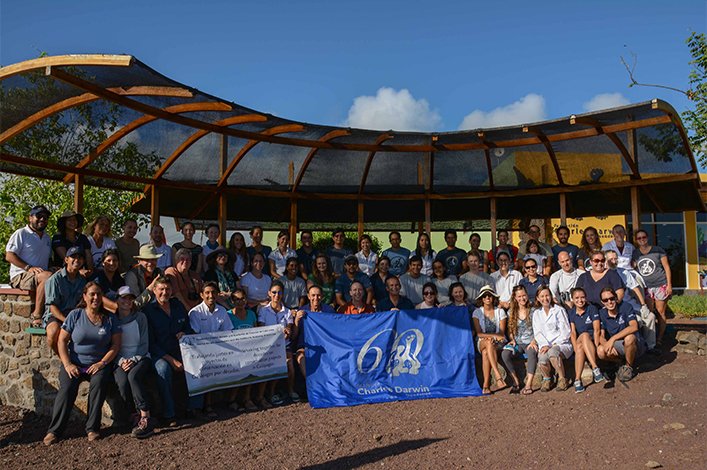The California Academy of Sciences (CAS) has a deep-rooted research history in the Galapagos. For decades, these islands have been visited by scientists and visitors as a living laboratory of evolution. The first expedition of scientists from the California Academy of Sciences was in 1905, the Academy continued to organize dozens of expedition trips afterwards.
The California Academy of Sciences shelter the world's largest collection of scientific specimens from the Galapagos, especially a collection of finches, so significant that it continues to help researchers to answer scientific questions to this day. The majority of CAS Galapagos fieldwork now focuses on the marine environment, where dozens of new species have been discovered in the last decade.
In September 2017 and at the end of July 2018, the Executive Director of the Charles Darwin Foundation, Dr. Arturo Izurieta visited the headquarters of the California Academy of Sciences in San Francisco and began the exploration of potential forms of collaboration, after many decades of friendship and association in many scientific projects.
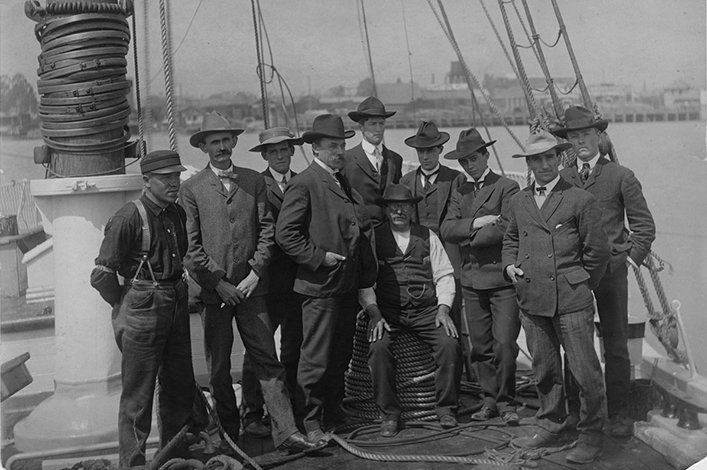
The 2019 expedition of the California Academy of Sciences arrived in Galapagos in mid-January for two weeks. They arrived with a team of several experts and, among them, a specialized team to assembly the skeleton of a dwarf sperm whale Kogia sima, in the Exhibition Hall of the Research Station, in Santa Cruz Island.
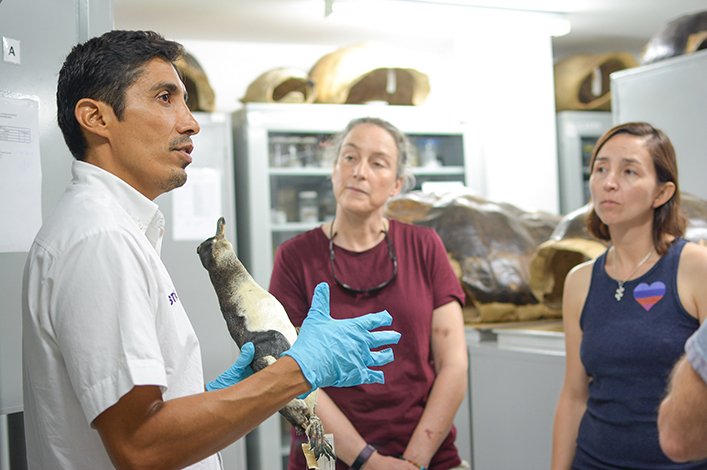
The assembly work was available for the community, tourists and the general public to show the live work of international scientists and specialists. The skeleton will remain on display at the Charles Darwin Research Station where visitors can learn more about this magnificent marine mammal from March.
Shannon Bennett, Science Director of CAS comments on the Discoveries in the Galapagos video: A Longtime Partnership | California Academy of Sciences: "We are really looking forward to diving back in and reengaging with the Charles Darwin Foundation and research collaboration, as well as engaging with the people of Galápagos."
In this framework, and trying to recover our friendship bonds of so many years, several activities parallel to the assembly were planned, such as a workshop with our scientists to learn about possible mutual collaboration projects, a Bioblitz was organized (citizen science census) and the training of the iNaturalist application.
Assembly of the Skeleton of the Dwarf Sperm Whale and the visit of the "man of the bones"
The staff working on the assembly of the skeleton Moe Flannery, Martha Velez from the California Academy of Sciences, and Lee Post who is the expert flown from Alaska to work in Galapagos! The team was supported by Gustavo Jiménez, Senior Researcher of the Charles Darwin Research Station and Stefan Loosveld the Coordinator of Institutional Promotion.
Lee Post also known as the "Boneman" has always been passionate about the natural world. He began his work as a skeleton articulator at the Pratt Museum in Homer Alaska with a 5-meter (17-foot) Beaked Whale skeleton. Since then he has articulated countless specimens for museum displays around the USA and the world.
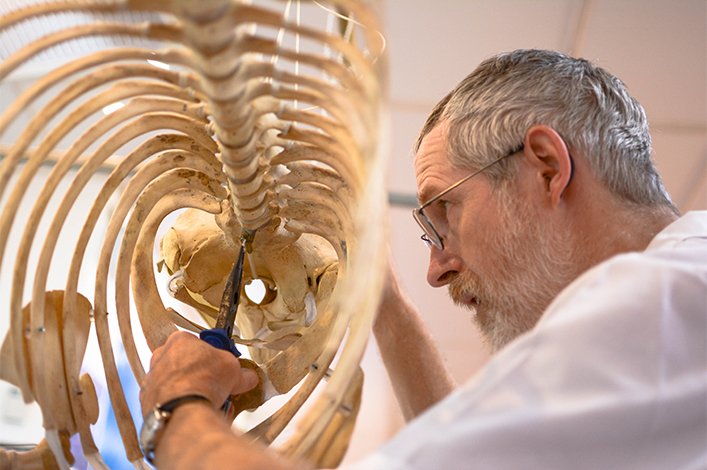
Lee specializes in leading community-based articulation projects with volunteers, especially high school students. Originally a Bookseller in Homer, Alaska, he wrote, illustrated, and published the 10 volume “Bone Building Books” and the “Bone Guide” to share his skeleton articulation techniques with the world (www.theboneman.com).
Lee says: "I never imagined coming to Galapagos, this is the best place to come if you are interested in nature." He adds: "The sperm whale assembly was a success, the space was appropriate and it was very satisfying to have tourists, students and entire families, observing and asking about the assembly. In this process, Martha's hard work helped us a lot, since she provided information in English and Spanish to the public. "
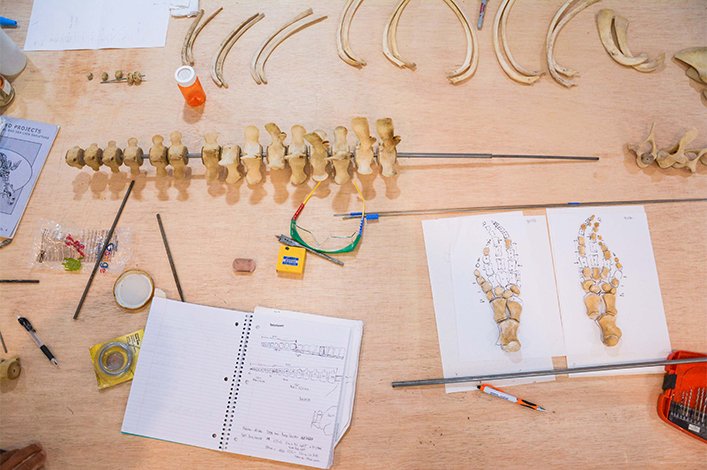
Moe Flannery, Senior Collections Manager at CAS, manages over 140,000 bird and mammal specimens. These specimens originate from all parts of the globe and range in size from an 80’ blue whale skeleton to tiny hummingbird eggs. Moe serves as Principal Investigator on several grants supporting work with the Marine Mammal Stranding Network. In that capacity, she directs field collecting of marine mammal specimens along 400 miles of California coastline.
"I wanted the assembly of the whale to be in a public place and that the community could observe the step by step process of its construction. When they told us about the Exhibition Hall of the Charles Darwin Research Station, I knew it was the perfect place to do it. We planned 2 weeks of work and an additional week in case of any emergency, however, everything went perfectly and during the two weeks we managed to complete the assembly. "Moe comments, she always wanted to visit the Galapagos Islands.
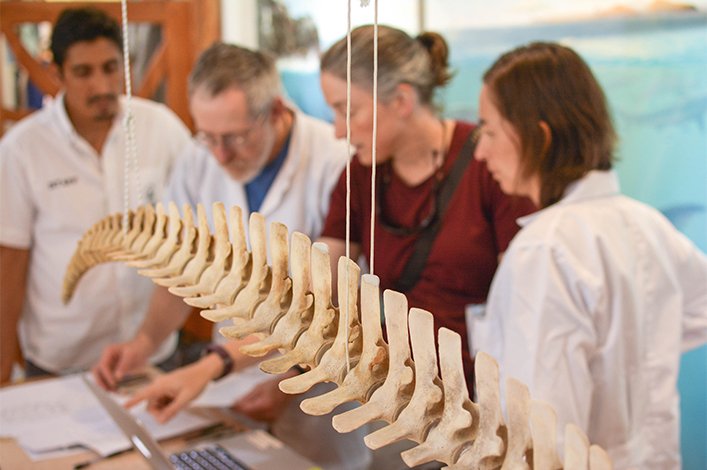
Information about the Dwarf Whale
The Galapagos National Park rangers discovered the body of a beached dwarf sperm whale on Isabela Island, near Puerto Villamil, in August 2015. When this sperm whale body was found, it was 1.84 m long. The cause of its death is unknown. A few weeks later, the specimen was picked up by local biologist Godfrey Merlen, who cured (cleansed and prepared) the bones. From that date, he kept the skeleton under his care and at the beginning of this year he delivered the specimen to the collection of the Charles Darwin Foundation to exhibit it and to be an instrument of education for the community and the general public.
The importance of this whale, Godfrey explains, is that "very little is known about this rare species of whale because it spends much of its life diving more than 300 meters deep into the ocean. Preserving its bones represents one of the few evidences of its presence near the Galapagos Archipelago."
BioBlitz: citizen science census
During their visit, we also conducted a citizen science census called BioBlitz with the participation of the local community, who were trained on the use of the citizen science application developed by National Geographic and the California Academy of Sciences - iNaturalist.
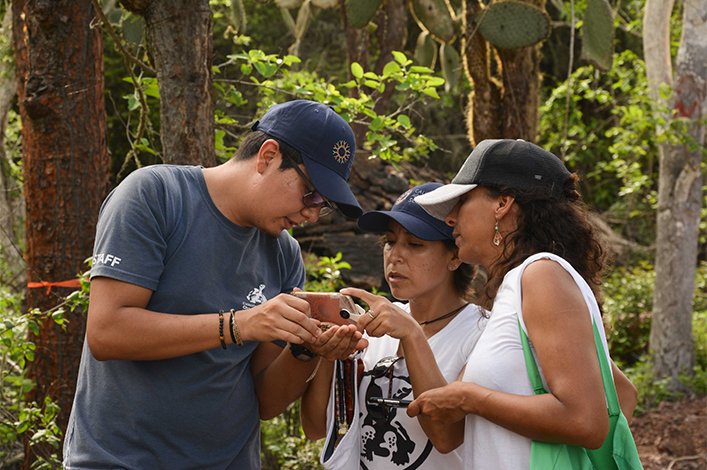
Rebecca Johnson and Alison Young Co-Directors of Citizen Science of the CAS, held several workshops to train our team of scientists and the community about the use of Bioblitz app. Citizen science censuses conducted with the community were enjoyed by children and adults.
The BioBlitz was held on January 24th, with the support of 40 people and we covered 3 different environments: the station beach, the Tortuga path and the Barranco. At the end of the exercise we recorded a total of 124 observations and 37 species.
Paola Díaz Freire, Communication Coordinator of the Charles Darwin Foundation, comments: "by living in a place as unique as Galapagos we can have the tendency to take for granted the space in which we live. Going out with a different group of people was enriching for all of us, especially with CAS scientists "and adds: "During the BioBlitz we had the participation of parents, children, scientists, naturalist guides, as well as young people who are part of our SharkAmbassadors Club, who conducted the census on the water with other CAS members and with our team. They said that it was really fun to use this application to identify the nature that surrounds us. In general, I received very good comments from the participants ... We hope to continue doing more BioBlitz exercises with the community. "
California Academy of Sciences
The California Academy of Sciences is located in the city of San Francisco, United States and houses the world's largest collection of vertebrate specimens from the archipelago, especially a collection of finches, which is so significant that it continues to help researchers worldwide to the present. The second largest collection is at the Charles Darwin Research Station in Galapagos.
In mid-July of this year, we will visit the CAS for the NightLife event, as part of the celebrations of our 60th anniversary, which we will celebrate on July 23th. During this event we will have the opportunity to explain to the public about the diverse scientific activities that we carry out in Galapagos and we hope to obtain new strategic alliances and donors to continue with our mission.
We will continue working together with the California Academy of Sciences to share science, knowledge and establish future collaborations, as well as to include the community in the generation of science.
We thank all CAS members: Mike McGee (CEO), Shannon Bennett (Science Director), Moe Flannery, Martha Velez, Lee Post, Anna Simmons, Durrell Kapan, Jack Dumbacher, John McCosker, Lauren esposito, Katie Jewett, Rebecca Johnson, Alison Young, Terry Gosliner, Nick Perez y Carrie Seltzer por compartir su conocimiento con nosotros.
